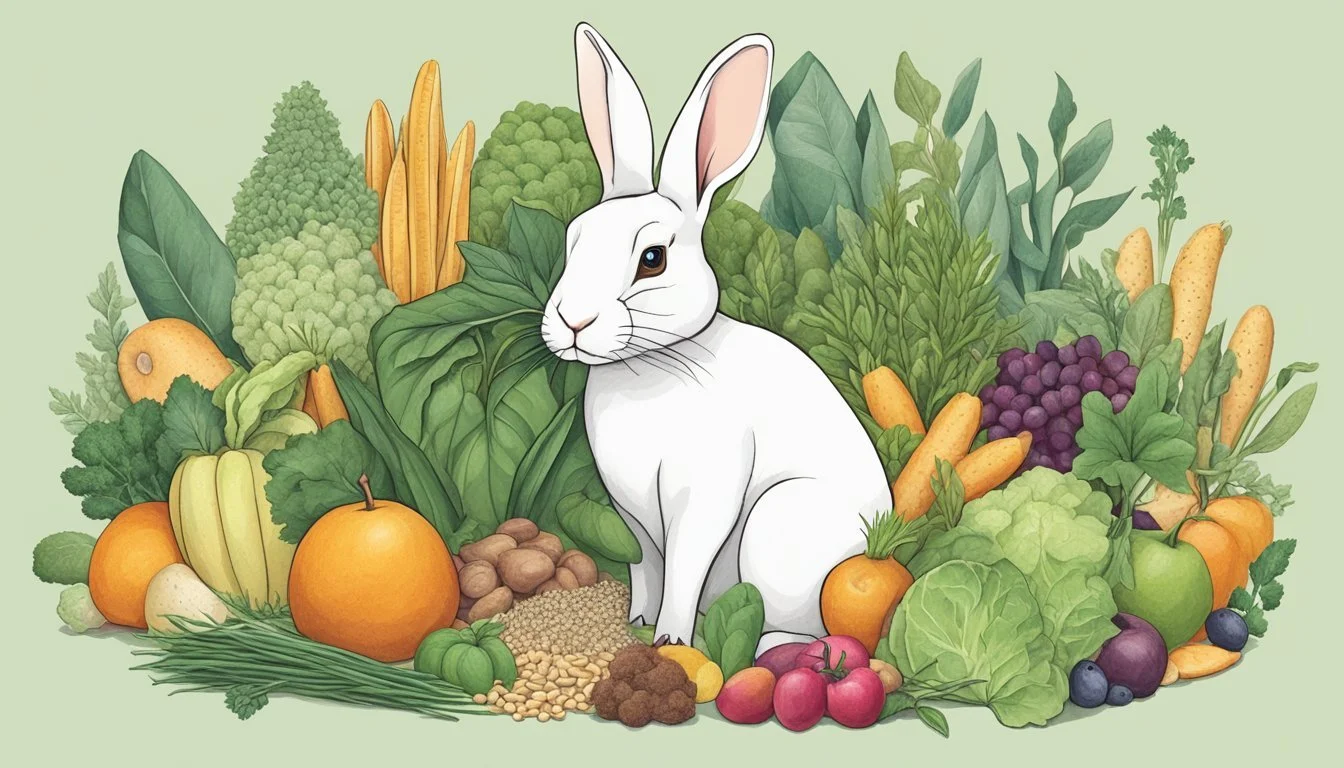Rabbit Substitutes
Best Alternatives for Pet Owners
Rabbit meat is a versatile protein, often sought after for its unique flavor and texture. Whether looking to replicate a medieval recipe or trying to create a dish with fewer calories and lower fat, rabbit serves as an excellent option. Chicken thigh meat is an easily accessible and economical substitute for rabbit meat, offering a similarly moist texture and mild taste.
For those who enjoy experimenting in the kitchen, other meats such as pheasant or quail can also provide a comparable culinary experience to rabbit. These poultry options, while sometimes harder to find, bring a similar level of richness and can be a pleasant change from the usual chicken. Additionally, more available meats like pork can be modified to replicate rabbit by marinating or cooking techniques that enhance juiciness and depth of flavor.
Exploring different culinary alternatives not only broadens your cooking repertoire but also ensures that you can enjoy your favorite recipes regardless of ingredient availability. By understanding the nuances of various meats, you can confidently substitute rabbit for these alternatives while maintaining the dish's intended flavor and texture.
Understanding Rabbit as a Dietary Choice
Rabbit meat offers a nutritious and versatile option for many culinary applications. It is particularly valued for its high protein content and lean nature, making it a healthy choice for diverse diets.
Nutritional Profile of Rabbit Meat
Rabbit meat is known for being rich in protein, offering around 20-22 grams per 100 grams of meat. This makes it an excellent source of energy and muscle repair for the body. Rabbit meat is also low in fat, with approximately 4 grams of fat in the same serving size, which can be beneficial for those monitoring their fat intake.
The meat is a good source of important minerals, including iron and zinc, which support various bodily functions like oxygen transport and immune system health. Additionally, rabbit meat has a low calorie count, ranging from 150-170 kcal per 100 grams, making it suitable for those looking to maintain or lose weight.
Culinary Uses of Rabbit
Rabbit meat can be used in numerous dishes, ranging from stews and roasts to grilled preparations. Its mild flavor pairs well with a variety of seasonings and herbs, such as thyme, rosemary, and sage. Rabbit is often used in traditional European cuisines, where it is braised or slow-cooked to enhance its tenderness.
It can be a great substitute for chicken in dishes like casseroles and soups, and its texture makes it suitable for ground meat recipes such as sausages and meatballs. By incorporating rabbit into different recipes, cooks can add diversity and a unique flavor profile to their meals.
Properly preparing rabbit ensures that its natural flavors shine, providing a delicious and satisfying meal option for the whole family.
Popular Rabbit Meat Substitutes
Rabbit meat is valued for its leanness and unique flavor, but finding it can be challenging and expensive. Several other meats can stand in for rabbit in recipes, each bringing its own characteristics and suitability for different cooking methods.
Chicken as a Substitute
Chicken, specifically the thigh meat, is often used as a substitute for rabbit due to its similar texture and taste. Chicken thighs offer a comparable protein content and can be prepared in much the same way as rabbit.
Thigh meat remains tender and juicy when cooked, making it suitable for roasting, braising, and stewing. Important: Ensure that the chicken is cooked to an internal temperature of 165°F (74°C) to guarantee safety.
Using Turkey as an Alternative
Turkey, particularly dark meat, can also be used in place of rabbit. Turkey's slightly stronger flavor and texture make it a good match for recipes calling for rabbit meat.
Turkey legs and thighs are ideal choices since they contain more fat and moisture compared to the breast. This moisture helps replicate the tenderness of rabbit. Cook turkey to an internal temperature of 165°F (74°C) to ensure it is safe to eat.
The Role of Pork in Mimicking Rabbit
Pork, especially cuts like tenderloin or loin, can effectively imitate rabbit meat. Pork offers a similar level of versatility and a comparable protein profile.
When choosing pork as a substitute, tenderloin is preferred for its leanness, while loin can be used for a slightly richer flavor. For best results, sear the pork on high heat to lock in juices, and finish it by roasting or grilling.
Beef: A Heavier Substitute
Beef, although heavier and richer than rabbit, can be used in recipes where its strong flavor will complement the dish. Select lean cuts like sirloin or round to substitute rabbit meat while maintaining a balance of protein.
Beef needs careful cooking to prevent it from overpowering the dish. Consider marinating beef to tenderize it and add subtle flavor notes. Cooking beef to an internal temperature of 145°F (63°C) ensures it is safe, especially when consuming medium-rare.
Using these substitutes effectively ensures that your recipes retain their intended flavor and texture, even when rabbit meat is not available.
Complementary Ingredients to Enhance Substitutes
When substituting rabbit in recipes, pairing it with the right complementary ingredients can significantly enhance the flavor. Focus on the thoughtful use of herbs, spices, vegetables, and fruits to create a balanced and delicious meal.
Herbs and Spices
Herbs and spices play a critical role in accentuating the flavors of substitutes like chicken. Basil and cilantro are particularly effective due to their aromatic qualities.
Basil leaves impart a sweet, peppery flavor that complements the mild taste of chicken. Incorporate fresh basil during the cooking process to retain its fragrance.
Cilantro, with its bright and citrusy notes, refreshes the palate. It is often used both cooked and fresh for its dynamic flavor profile.
Other herbs like rosemary and thyme also pair well, providing earthy undertones that marry beautifully with the substituted meat. Dandelion leaves can be included for their slightly bitter taste, offering a unique contrast.
Vegetables and Fruits
Using the right vegetables and fruits can transform your rabbit substitute dish. Root vegetables such as carrots, parsnips, and potatoes bring warmth and heartiness to stews and roasts.
Consider adding sweet and savory fruits like plums, which help to tenderize the meat and impart a subtle sweetness. Plums can be used in sauces or included directly in the dish for enhanced depth.
Leafy greens like spinach or collard greens offer a nutritious boost. They add color and texture while balancing the meal's flavors.
For a sophisticated twist, pair with seasonal vegetables like asparagus or Brussels sprouts. Their robust flavors complement the meat, creating a delightful culinary experience.
Cooking Techniques for Rabbit and Its Substitutes
Whether preparing rabbit or using a substitute, the cooking techniques greatly influence the dish's final taste and texture. Employing the right methods can transform these meats into succulent, flavorful meals.
Preparing Meat Substitutes
When substituting rabbit, the ideal choices are lean meats with similar textures. Chicken, particularly the thighs, and turkey can be excellent options. Preparing these substitutes involves ensuring they are tender and flavorful, similar to rabbit.
Before cooking, marinate the meat in a blend of herbs and spices such as rosemary, thyme, or garlic. This helps mimic the rabbit's subtle flavors. Browning the meat in a pan before slow cooking or braising can deepen the flavor.
Recipes and Preparation Tips on YouTube
YouTube offers a plethora of recipes and cooking tutorials that can help you master cooking both rabbit and its substitutes. Channels like "Chef's Tips" and "Gourmet Recipes" provide step-by-step instructions for various dishes.
One popular method is slow cooking, which ensures the meat remains tender. Videos typically demonstrate marinating the meat, browning it, and cooking it slowly over low heat. This technique is especially beneficial for novice cooks seeking to replicate traditional rabbit dishes with substitutes.
Dietary Considerations When Choosing Substitutes
When choosing substitutes for rabbit, it is crucial to consider potential allergens and how well the alternative balances nutrition and flavor. Ensuring any substitute maintains an optimal balance of nutrients is imperative to the health and satisfaction of the consumer.
Allergy and Sensitivity Concerns
For individuals with allergies, choosing the right substitute for rabbit meat can be vital. Some people may have sensitivities to certain proteins found in common alternative meats like chicken or beef. It's important to identify any known allergens within the family to avoid adverse reactions.
Moreover, some alternatives like tofu or tempeh, which can serve as plant-based substitutes, may cause allergies due to soy content. Pay attention to these sensitivities to ensure a safe and enjoyable meal.
Balancing Nutrition and Flavor
Nutrition plays a significant role when substituting rabbit meat. Rabbit is lean and high in protein, so the substitute should ideally mirror these benefits. For instance, chicken thighs and turkey provide high protein levels and are relatively low in fat, making them suitable replacements.
Additionally, it's essential to consider iron and energy content. Beef, while higher in fat, offers iron-rich benefits that are crucial for dietary balance. Lastly, flavor is as important as nutrition. Ensuring the substitute is delicious and well-seasoned can make the meal enjoyable without compromising dietary needs.







